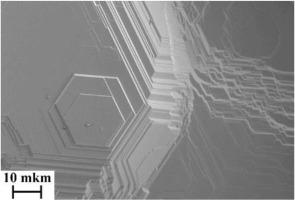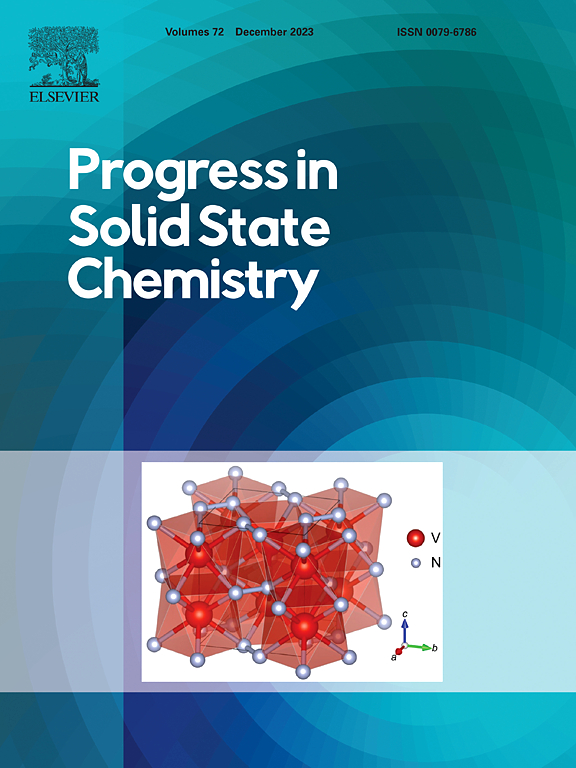Synthesis, structure and properties of substituted cobalt chalcogenides Co7(Se,Te)8
IF 10.5
2区 化学
Q1 CHEMISTRY, INORGANIC & NUCLEAR
引用次数: 0
Abstract
For the first time, polycrystalline samples of Co7(Se1–yTey)8 were synthesized in the entire concentration range (0 ≤ y ≤ 1) and studied by X-ray diffraction, scanning electron microscopy, and by thermal expansion, specific heat capacity and electrical resistivity measurements. Depending on the concentration of tellurium, the solid-phase reaction method (at y < 0.9) and melting method (at y ≥ 0.9) were used to obtain single-phase samples. A change in the crystal structure (P3121 → P-3m1 → P63/mmc → P-3m1) due to the disordering of vacancies, significant anisotropy of the thermal atomic displacement, and anisotropic lattice expansion have been observed in this system when selenium is substituted with tellurium. According to specific heat measurements, an increase in tellurium concentration is accompanied by a decrease in the electronic specific heat coefficient, which indicates an increase in the metallicity of the system and is confirmed by electrical resistivity data. In substituted compounds using thermal expansion and temperature-dependent X-ray diffraction, spinodal decomposition of samples was detected upon heating. The second phase in dendritic form was observed using scanning electron microscopy on the surface of slowly cooled tellurium-rich sample.

取代钴硫族化合物Co7(Se,Te)8的合成、结构与性质
首次合成了Co7(Se1-yTey)8在整个浓度范围(0≤y≤1)下的多晶样品,并通过x射线衍射、扫描电镜、热膨胀、比热容和电阻率测量对样品进行了研究。根据碲的浓度不同,分别采用固相反应法(y < 0.9)和熔融法(y≥0.9)获得单相样品。当硒被碲取代时,晶体结构发生了变化(P3121→P-3m1→P63/mmc→P-3m1),由于空位的无序性,热原子位移具有显著的各向异性,晶格扩展具有各向异性。根据比热测量,碲浓度的增加伴随着电子比热系数的降低,这表明体系的金属丰度增加,并得到电阻率数据的证实。在取代化合物中,使用热膨胀和温度相关的x射线衍射,在加热时检测到样品的spinodal分解。用扫描电镜观察慢冷富碲试样表面的第二相为枝晶。
本文章由计算机程序翻译,如有差异,请以英文原文为准。
求助全文
约1分钟内获得全文
求助全文
来源期刊

Progress in Solid State Chemistry
化学-无机化学与核化学
CiteScore
14.10
自引率
3.30%
发文量
12
期刊介绍:
Progress in Solid State Chemistry offers critical reviews and specialized articles written by leading experts in the field, providing a comprehensive view of solid-state chemistry. It addresses the challenge of dispersed literature by offering up-to-date assessments of research progress and recent developments. Emphasis is placed on the relationship between physical properties and structural chemistry, particularly imperfections like vacancies and dislocations. The reviews published in Progress in Solid State Chemistry emphasize critical evaluation of the field, along with indications of current problems and future directions. Papers are not intended to be bibliographic in nature but rather to inform a broad range of readers in an inherently multidisciplinary field by providing expert treatises oriented both towards specialists in different areas of the solid state and towards nonspecialists. The authorship is international, and the subject matter will be of interest to chemists, materials scientists, physicists, metallurgists, crystallographers, ceramists, and engineers interested in the solid state.
 求助内容:
求助内容: 应助结果提醒方式:
应助结果提醒方式:


